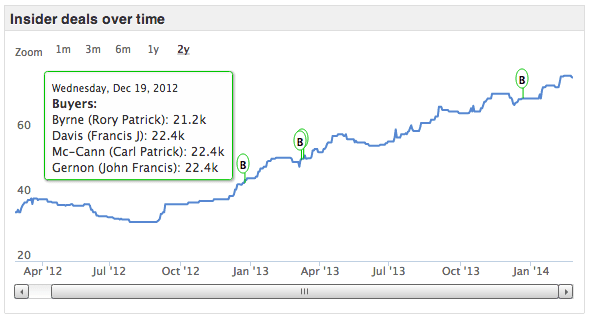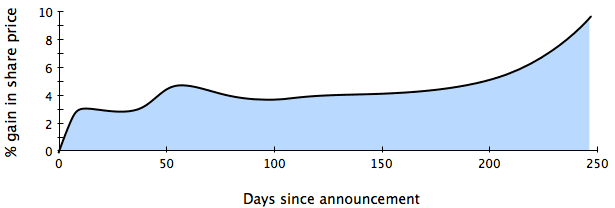How to profit from boardroom buying and selling
Whenever you approach the stock market it’s worth considering that the guy on the other side of the trade may be better informed than you are. When you’re buying, he’s selling, when you’re selling, he’s buying. One of you has to be wrong.
While regulators work hard to ensure that price sensitive information about stocks is fairly disclosed, there are still plenty of individuals with a huge information advantage. Without question, those with the most intimate knowledge of a company’s future prospects are its ‘insiders’ - the directors and officers who run it on a daily basis.
What works in director dealings?
In his excellent book The Zulu Principle[1], celebrated growth stock investor Jim Slater, stressed:
Particular note should be taken of buying by the chief executive and finance director. They ought to know exactly what is happening within the business and it is always encouraging to see them put their money where their mouth is.
Studies suggest that simple strategies that buy stocks after director share purchases can beat the market by anywhere between 5% and 10% annually. The catch is that a pure ‘insider tracking’ strategy can lead to quite lumpy profits. Sometimes a strategy like this can under-perform for a couple of years before outperforming again - and not many people can handle that.
So the trick is to use insider trading signals as a confirming factor. Some of the world’s most successful specialist hedge funds copycat director trading signals as part of diversified trading strategies. One study noted that combining director buying signals in cheap stocks with moving share prices (a Value & Momentum strategy) significantly boosted profits to a total of 23.5% annually[2].
There have been reams of academic studies since the the 1960s which have aimed to figure out precisely how best to profit from insider trades. While information on director dealings is widely available, not all purchases are meaningful. It’s essential to know precisely how to read them. We have distilled the best of them into a set of 6 Key Rules.
Rule 1: Buy signals tell you more than sell signals
Many investors become terrified when they see a director selling shares. But the fact is that insider ‘sells’ are often made for personal reasons rather than concerns for the company’s prospects. The reasons may be as simple as buying a house, diversifying wealth or payment of tax. Selling can also coincide with the exercising of vested share options, which are often tied to long term incentive and remuneration plans.
So generally the link between directors’ sales and lower future returns on a per-stock basis is fairly weak, except when stocks are on very high valuations. By contrast, insider purchases have widespread predictive value… especially when used in unison with Rule 2. In his best-selling book One Up on Wall Street[3], ex-Fidelity star fund manager Peter Lynch, explained:
Insiders might sell their shares for any number of reasons, but they buy them for only one: they think the price will rise.
UK-focused research has found that company directors often trade in a contrarian fashion[4]. This means that they are particularly good at buying stocks when the market is undervaluing them and selling when those stocks become expensive. Buying signals in smaller, value shares have been shown to be particularly strong indicators of future price movement, with positive returns carrying on for up to two years after the trade.
Rule 2: Focus on intensive buying by multiple directors
One of the most important patterns in director dealings is cluster buying, or those periods when several directors are snapping up stock at the same time. When more than three directors in the previous three months have bought a stock, returns on average are 2% per month higher than the market. These conviction trades are some of the best at predicting share price outperformance.
Case Study: Cluster Buying leads to standout gains in Total Produce
When the directors of ‘Total Produce’, the fresh foods distributor, started seeing value in their stock and momentum in their business they signalled their confidence with a set of cluster buys. Total Produce went on to deliver a 76% gain over the next 14 months rewarding fleet footed private investors who were able to follow their lead.
They also dramatically reduce the risk of misinterpreting ad hoc buying and selling by directors that may otherwise mean very little. Analysis of cluster buying has found that the higher the number of net purchases by multiple directors over the past three months, the more profitable those trades will tend to be for the directors involved.
There are various ways to calculate the buying intensity. Some use the ‘Net purchase ratio’ which is the difference between buys and sells compared to the total. Others simply look for cases where the number of buyers is greater than the number of sellers plus 2. Regardless of technique, buying intensity is the single most important factor in director dealings.
Rule 3: Act on buy signals as quickly as possible
To really gain from insider signals it pays to act very, very quickly after the information is released to the market. While insider trades have been shown to be profitable signals for the first nine months after they are disclosed, on average about half of the profits are made within the first 60 days and a quarter are made in the first 10 days. The great advantage for individual investors is that they can trade in small size, seizing on these market inefficiencies in a way that hedge funds can’t.
Rule 4: It pays to track the directors rather than officers
Meetings of a company’s management board are the only place where the most sensitive information about operations and finances is shared. While all directors are company officers, not all officers are directors. Clearly one would expect that executive director buying (especially the CEO and CFO) is more valuable than other regular officer buying and the data bears this out. Interestingly, shareholders with a 10%+ interest also seem to have more information than officers. So, evidence shows that you should place your bets with the board.
Rule 5: Focus on larger trades in small value stocks
Director purchases have more value when stocks are very cheap, and especially when they are distressed. There are also higher returns achievable from following director dealings in small and micro cap stocks where it’s much harder for hedge funds to deal effectively and in size.
Research by Lakonishok and Lee[5], who scrutinised one million trades in the period 1975 to 2005, found that director dealings was a particularly strong indicator in small cap value stocks. They looked specifically for strong buy and sell signals and found the highest returns were produced when at least three different insiders were trading sizable amounts of stock.
Rule 6: Focus on companies in less cyclical sectors
Some of the worst returns from insider trades occur in companies in cyclical sectors - such as energy and mining. These sectors have profit cycles tied more closely to macro-economic factors. It’s better to focus on director dealings in consumer staples, finance, services and technology stocks. There are almost double the profits to be made trading off director signals in defensive shares (such as food and beverages) than cyclicals (like housing and cars).
Summary: How you can profit from director dealings
While taking a lead from company executives sounds like an intuitive investing strategy, it hits trouble when you realise that not all director dealings tell the same story. For private investors, here are the key factors to focus on:
Directors that are buying stock rather than selling.
Clustered purchases by multiple directors.
Trading by the most senior board members.
Recent, large trades in small cap value stocks.
Acting quickly to piggyback these significant insider trades can lead to much improved returns. Overall, private investors should be looking for signs of confidence including directors that are making big recent purchases, regular buying activity and multiple top executives increasing their stakes. Incorporating insider activity into a value and momentum strategy can bring standout returns.
- Jim Slater. The Zulu Principle.
- Daniel Giamouridis, Manolis Liodakis and Andy Moniz. Some Insiders are Indeed Smart Investors.
- Peter Lynch. One Up On Wall Street: How To Use What You Already Know To Make Money In The Market.
- Alan Gregory, Rajesh Tharyan and Ian Tonks. More Than Just Contrarians: Insider Trading in Glamour and Value Firms.
- Josef Lakonishok and Inmoo Lee. Are Insider Trades Informative?.



